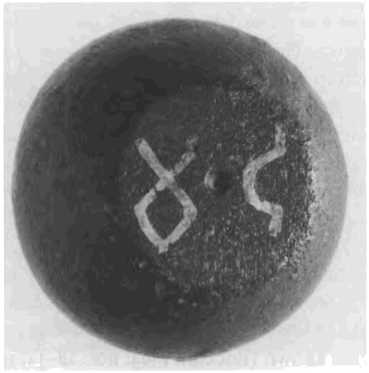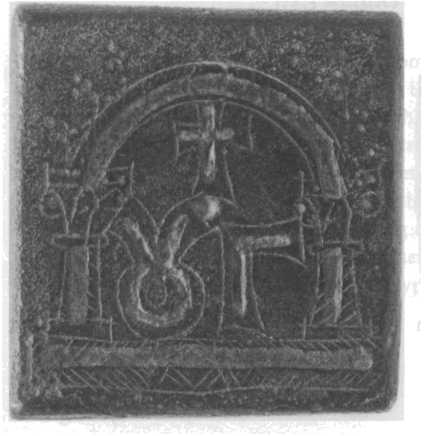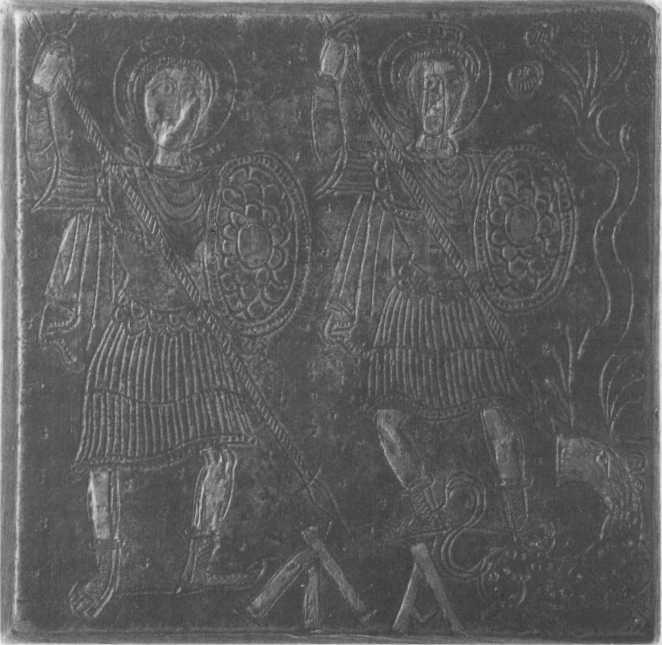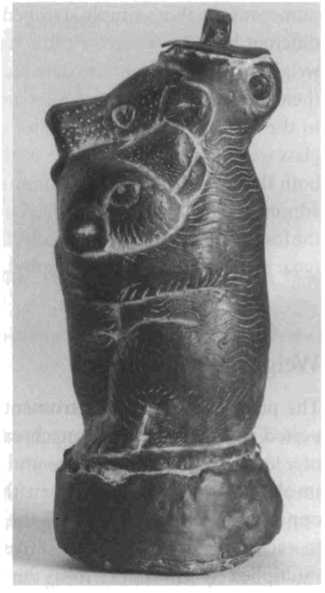Metal
Three shapes were predominantly employed in the manufacture of Roman and Byzantine metal weights. The earliest, in the form of a flattened sphere doubly truncated, is derived from Roman stone weights (Fig. 1). Although a few sixth-century examples are known, the majority of this type found in the eastern Mediterranean are probably to be dated between 200 and 450 ce. Recent excavations in Rome at the Crypta Balbi suggest that, in the west anyway, the spheroidal type was still being produced in large quantities well into the sixth century. Flat weights in the form of a square seem to have been the main type for much of the fifth and sixth

Fig. 1 6 oz spheroidal copper-alloy weight, c.200-400 CE
(Department of Prehistory and Europe, British Museum)
Centuries, with weights in the form of a flat disk not becoming the predominant type until the seventh century. One of the earliest dated discoid examples comes from the 560s; slightly later dated examples are known from the tenth year of Justin IVs reign in 575, and from the tenth year of Maurice Tiberios’ reign in 592 (Buckton 1994: no. 81). Seventh-century weights from archaeological contexts tend to be discoid. All the weights, for instance, from the shipwreck at Yassi Ada off the south-western coast of Turkey and the recent excavations at Bet-Shean in Israel and Mafraq in Jordan are discoid and from the seventh or eighth century. Other discoid Byzantine weights were adapted for use by Arab officials who were in office in the 690s or between 705 and 715. The recent excavations at San Vicenzo al Volturno in Italy unearthed a workshop at the southern end of the site. Among the metalwork finds was a 2 oz discoid weight thought to have come from the first phase of occupation of the workshop, dated by coins to c.820-30. If the chronology at Corinth is correct then discoid weights were still being produced as late as the eleventh century, a dating supported by the recent excavations of the Serce Limani shipwreck. No commodity weights from the twelfth century to the fall of Constantinople have been identified (see Entwistle 2002 for bibliography on these sites).
Most Byzantine weights are simply marked with their relevant denomination and perhaps a subsidiary decorative motif such as a cross. It is possible, however, to identify and roughly date certain iconographic types. The most popular in the Early Byzantine period is the ‘cross within wreath type’. This takes two forms: a wreath enclosing a prominent standing cross flanked by the denominational mark, or a wreath enclosing a cross above the denominational mark. These two designs are generally found on square weights dating from the fifth and sixth centuries and are found throughout the Empire, ranging from Holland in the north, to Portugal in the west, to the Sudan in the south and to the Crimea in the east. Other distinctive types include weights with architectural decoration—either a single arch enclosing a cross and the denomination (Fig. 2), or a facade composed of two triangular arches and one rounded arch enclosing the same—or ‘imperial’ weights, that is, weights decorated with one or more imperial figures. The standard format for this type depicts two imperial busts, nimbed, diademed, and wearing paluda-menta, within a wreath. More elaborate examples show standing emperors with shields, spears, or bows engaged in abbreviated hunting scenes or juxtaposed with other figures such as Tyches or Victories; many of these weights are embellished with silver or copper inlays (Fig. 3). The only other series of weights exclusively decorated with imperial figures are exagia solid! (Fig. 4). Introduced by Julian, most are to be dated to the late fourth or early fifth centuries, although examples dating from the reigns of Marcian and Leo, identifiable from the imperial monograms which decorate their reverses, are known (Buckton 1994: nos. 28-34, 79-82, 108).
Fig. 2 3 oz copper-alloy weight with architectural decoration, 4th-5th century CE

(Department of Prehistory and Europe, British Museum)

Fig. 3 1 lb copper-alloy weight with two emperors, late 4th-late 5th century CE
(Department of Prehistory and Europe, British Museum)

Fig. 4a and b Copper-alloy exagium solid! with Honorius and Theodosius, and Fortuna (rev.), 408-23 CE
(Department of Prehistory and Europe, British Museum)
Glass
Byzantine glass weights are normally discoid in shape, with the majority of them bearing monograms or inscriptions relating to their issuing authority, the prefect of Constantinople. They were produced in a wide variety of colours, but with four predominant: a dark blue, a blue-green, a pale greefi, and a yellow-brown. The precise function of these glass disks, that they were intended to weigh the solidus and its divisions, has occasionally been disputed on the grounds that they do not always correspond exactly with known coin denominations. The assumption implicit in this argument is that these weights were originally intended to be highly accurate measures of coins, and not, as contemporary coin balances would suggest, simply rule-of-thumb weights for checking the tolerance above or below which a coin would not be accepted. A recent statistical analysis of over five hundred examples suggests that the majority of them were intended to weigh the solidus/nomisma (theoretical weight 4.54 g) and its divisions the semissis (theoretical weight 2.27 g) and tremissis (theoretical weight 1.55 g). A very rare group of glass weights stamped with denominational marks illustrates that they were made to weigh not only lightweight solidi and multiples of the solidus, but also multiples and divisions of the ounce.
Many different iconographic types of glass weights are known, but the majority fall into the following seven categories: weights stamped with a box monogram; with a cruciform monogram; with a central monogram enclosed by an inscription; with one or more imperial busts sometimes juxtaposed with a monogram or the bust of an eparch or Christ; with the bust of an eparch with accompanying inscription; with a denominational mark; and, finally, weights with debased monograms or busts, sometimes referred to as Arabo-Byzantine’ because they are thought to have been issued by Coptic merchants in the administrative vacuum following the fall of Egypt to the Arabs in the 640s and before the introduction of purely Arabic glass weights by Abd al-Malik in 691. Of these seven categories the most numerous are those simply stamped with a box or cruciform monogram. So many different types have survived that it suggests that if the rough chronology for glass weights is correct (most are dated to the sixth and first half of the seventh century) then the monograms must refer not only to the prefects of Constantinople but to the eparchs of the major cities of the empire. The eventual disappearance of glass weights during the course of the seventh century can probably be ascribed to both the contraction of the economy during this period and the disruption of the administrative apparatus involved in their manufacture and distribution following the loss of such key provinces as Syria and Egypt to the Persians and Arabs (Buckton 1994: nos. 82-91, with bibliography).
Weighing Equipment
The principal weighing instrument for large commodities during the Byzantine period was the kampanoSy anachronistically known as the steelyard. This consists of a lever of two unequal arms and two or three fulcra. The mechanical principle involved is a simple one. When the lever is in a state of equilibrium, the two opposing forces, the weight of the item and the weight of the counterpoise are to each other inversely as the arms of the lever, or that the item to be weighed multiplied by its distance from the fulcrum equals the weight of the counterpoise multiplied by its distance from the fulcrum. The lever in most instances takes the form of a beam of rectangular cross-section with three suspension hooks acting as fulcra. From the shorter arm hangs a suspension unit to support the goods to be weighed, while the longer arm is graduated on three of its faces, corresponding to the fulcra. Along this arm, the counterpoise weight would be moved until a state of equilibrium was attained and the weight of the goods indicated by its position on the relevant scale. For the scale to be legible the steelyard would have to be hung with the suspension chains at the right and the scales rising towards the left. The outermost fulcrum was used for the heaviest, the innermost for the lightest amounts. Only one counterpoise weight was calibrated for use in all positions.
Counterpoises, which only survive for the Early Byzantine period, took various forms, both figural and non-figural. The latter normally consist of spheres or hemispheres of copper-alloy sheet covering a lead core. Figural counterpoises included animals such as bears (Fig. 5) or baboons, or human representations of emperors, empresses, Tyches, or Greek goddesses, with Athena/Minerva being the most popular type (Franken 1994).
For weighing lighter amounts or coins two other weighing implements were preferred: the equal-arm balance and the folding counterpoise balance. The former is a simple beam from the ends of which are suspended two pans. One is used for the goods to be weighed, the other for the weights. The fulcrum was either a central
Fig. 5 Copper-alloy counterpoise weight in the form of a bear cuddling its cub, 5th-6th century ce

(Department of Prehistory and Europe, British Museum)
Hook or a central indicator or pointer. The folding balance, which seems to have been employed mainly for coins, has a collapsible beam which has a joint in each arm equidistant from the fulcrum, allowing it to be folded when not in use.
References
Bendall, S. 1996. Byzantine Weights: An Introduction (London).
Buckton, D. (ed.) 1994. Byzantium: Treasures of Byzantine Art and Culture from British Collections (London).
Entwistle, C. 2002. ‘Byzantine weights’, in EHB: 611-14.
Franken, N. 1994. Aequipondia: figurliche laufgewichte romischer und fruhbyzantinischer Schnellwaagen (Alfter).
Kushnir-Stein, a. 1995. ‘Two inscribed weights from Banias’, Israel Exploration lournal 45.1: 48-51.
Nicole, J. (ed.) 1970. To eparchikon biblion {The Book oftheEparch) (London).
ScHiLBACH, E. 1970. Byzantinische Metrologie (Munich).




 World History
World History









